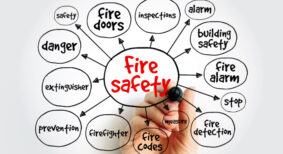As the importance of cleaning and sanitizing remains top of mind, it is crucial that cleaners use the right products to achieve optimal results. In recent years, we’ve moved from cleaning just for appearance to making hygiene and safety a vital component of the process. Focusing on practicing cleaning, sanitizing, and disinfecting each step effectively will help ensure a safe and hygienic environment.
According to the CDC, their definitions are as follows:
- Cleaning means using commercial cleaners that contain soap or detergent to decrease the number of germs on surfaces and reduce the risk of infection from surfaces in your facility. Cleaning alone removes most types of harmful germs (like viruses, bacteria, parasites, or fungi) from surfaces.
- Sanitizing reduces the remaining germs on surfaces after cleaning.
- Disinfecting can kill harmful germs that remain on surfaces after cleaning. By killing germs on a surface after cleaning, disinfecting can further lower the risk of spreading disease.
Disinfectants
A disinfectant is a substance or a combination of substances that irreversibly inactivates bacteria, fungi and viruses but does not always affect bacterial spores in the inanimate environment, such as on hard surfaces.
Becoming familiar with disinfectants and their specific roles is critical for effective commercial cleaning and sanitization. Here is a guide to some of the common disinfectants and their most effective methods of use:
Alcohol: Referring to two water-soluble chemical compounds (ethyl alcohol and isopropyl alcohol), alcohol is a cleaning anti-bacterial agent. In addition to their germicidal properties, alcohols are also tuberculocidal, virucidal, and bactericidal but do not destroy bacterial spores. These products evaporate quickly, and water may need to be applied repeatedly to continue to use for a longer period of time. As well, alcohol may damage surfaces like shellac, plastic, and glue, so care must be taken when using these products.
Protecting your staff, visitors and facility from pathogens means knowing what products to use for proper and effective sanitization. Choose the correct and appropriate products for your business, read ingredients and follow label instructions, and instruct cleaning staff on proper use to keep your facility clean and safe.
Chlorine and chlorine compounds: Hypochlorites, the most widely used of the chlorine disinfectants, are available as liquid (e.g., sodium hypochlorite) or solid (e.g., calcium hypochlorite). These are a good choice as they have a broad spectrum of antimicrobial activity, tend not to leave toxic residues, are unaffected by water hardness, are inexpensive, and are fast-acting. Although these disinfectants are safe for use on foodservice surfaces like communal kitchens (as long as the proper dilution ratio exists), they can be ineffective at killing germs on a dirty surface. They are also corrosive and may eat away at surfaces with continual use over time.
Phenolics: This product is phenol based, which is effective on a wide range of germs and bacteria. Many of these products can be used as a cleaner and disinfectant for a one-step process. This product must be used with the appropriate PPE, as phenolics can be hazardous to humans, potentially causing irritation of the eyes, skin, and respiratory tract. They may also cause damage to flooring, so caution must be taken when using these for floor care.
Peroxide: Peroxide-based disinfectants can be used for their germicidal, bactericidal, and virucidal properties, and are typically quicker at killing germs than other options. These could cause damage to flooring, so use carefully to avoid surface etching and a dull floor finish.
Iodophors: These are a combination of iodine and a carrier detergent, and this means that dilution is necessary for use. One advantage of this disinfectant is that it is not affected by water, so hard water will not be a deterrent in the disinfecting process. Avoid using this combination on plastic because staining may occur.
Quaternary ammonium compounds: These are commonly used in disinfecting solutions due to their high level of effectiveness in addressing germs and bacteria. As well, some of these compounds can be used as combination cleaners and disinfectants, so they can speed up the process with one-step disinfection. It is especially important to use this product as per the label or instructions, as there is a risk of binding, which means that they can be absorbed by the cloth as you are trying to apply them to a dirty surface.
Knowing the benefits and drawbacks of each type of disinfectant and using them accordingly can help you achieve better cleaning results and keep your facility and staff safer.









